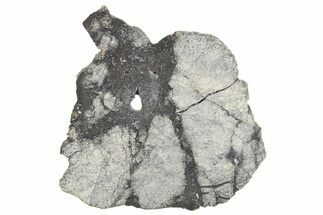This Specimen has been sold.
1.45" Eucrite Meteorite (31 g) Section - From 4 Vesta Minor-Planet
This is a 1.45" wide (31 gram) section of an Eucrite meteorite, NWA 15923. Material from this meteorite is quite popular because the patterning of the breccia makes people think of moon rocks. This section of meteorite has been cut flat on one side. A thin coat of sealant has been applied to the cut face to bring out the details of the breccia.
The NWA 15923 Eucrite Meteorite
This meteorite was discovered in 2022 when 105 kilograms of fusion-crusted achondritic material was purchased from a meteorite dealer in Mauritania. It was likely found by nomads in the Sahara Desert, who are responsible for most North African meteorite finds. The largest stone of this find was 12 kilograms. A 433.7-gram stone was donated to the Buseck Center for Meteorite Studies at Arizona State University.
Meteoritical Bulletin: Entry for The NWA 15923 Meteorite
This meteorite was discovered in 2022 when 105 kilograms of fusion-crusted achondritic material was purchased from a meteorite dealer in Mauritania. It was likely found by nomads in the Sahara Desert, who are responsible for most North African meteorite finds. The largest stone of this find was 12 kilograms. A 433.7-gram stone was donated to the Buseck Center for Meteorite Studies at Arizona State University.
Meteoritical Bulletin: Entry for The NWA 15923 Meteorite
Eucrite Meteorites - Fragments Of 4 Vesta
Eucrites are achondritic stony meteorites thought to have originated from the surface of the giant asteroid (or minor planet) 4 Vesta. Vesta is the second largest body in the asteroid belt, measuring 326 miles wide. Like Earth, it has the differentiated layers of crust, mantle, and core common to rocky planets: this may mean that 4 Vesta is the remnant of a larger destroyed planet.
Eucrites consist of basaltic rock from Vesta's crust ejected during a collision with another asteroid. Eucrites are mostly composed of calcium-poor pyroxene, pigeonite, and calcium-rich plagioclase (anorthite). Vesta is currently one of just seven identified solar system bodies of which we have physical samples.
Eucrites are achondritic stony meteorites thought to have originated from the surface of the giant asteroid (or minor planet) 4 Vesta. Vesta is the second largest body in the asteroid belt, measuring 326 miles wide. Like Earth, it has the differentiated layers of crust, mantle, and core common to rocky planets: this may mean that 4 Vesta is the remnant of a larger destroyed planet.
Eucrites consist of basaltic rock from Vesta's crust ejected during a collision with another asteroid. Eucrites are mostly composed of calcium-poor pyroxene, pigeonite, and calcium-rich plagioclase (anorthite). Vesta is currently one of just seven identified solar system bodies of which we have physical samples.
TYPE
Eucrite Melt Breccia
AGE
LOCATION
Northwestern Africa
SIZE
Size: 1.45 x 1.25", up to .63" thick, Weight: 31 grams
CATEGORY
SUB CATEGORY
ITEM
#304292
 Reviews
Reviews













